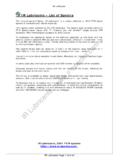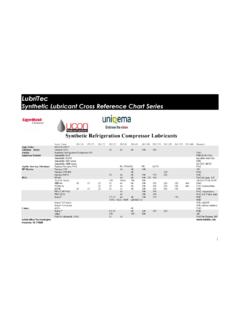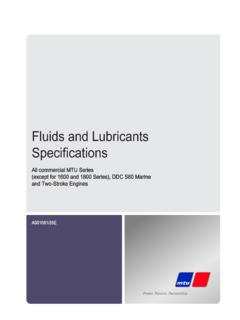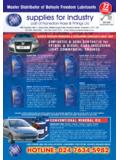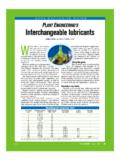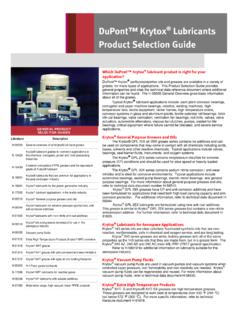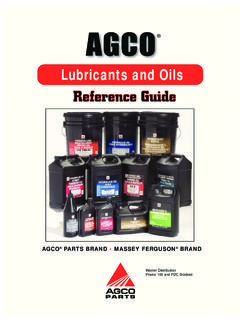Transcription of Overview of oxidation laboratory tests on industrial ...
1 Overview of oxidation laboratory tests on industrial lubricants - Lubmat 16. V. Bouillon - BfB Oil Research IESPM GROUP, Les Isnes, Namur, Belgium Abstract Lubricating oils are very important products without which no equipment or engines can run. This paper focus on a oil key property in industrial systems which is the oxidation resistance and the thermal stability. After a short review of oil composition and the mechanism of lubricant oxidation , the main normalized laboratory tests designed to evaluate this performance are described with reference to national, international or OEM. specifications. Keywords: laboratory testing, oil degradation, oxidation , thermal stability, industrial oil, specifications, test,, BfB Oil research. 1 INTRODUCTION Base oils The technologies and industrial material developments Lubricating base oils are mixtures of a large number of lead the additives and lubricants manufacturers to chemical compounds and are therefore characterized by elaborate higher performance lubricants .
2 One of the key the following physico-chemical properties : characteristics, besides antiwear and EP resistance, good Viscosity and VI (indicates viscosity temperature surface properties, anti-corrosion protection is the relationship), specific gravity, cloud and pour point . oxidation and thermal stability. There was a need to flash, fire and auto-ignition point, aniline point, evaluate the performance of these oils using laboratory composition (content of paraffinic, iso-p., naphtenics, bench tests . The thermal and oxidation characteristics can aromatics, saturates, sulfur), carbon residue, volatility, air be evaluated by many tests which some are detailed release value, water separability, thermal stability, eco- below. This paper relates to the following applications: toxicity and biodegradability, . - Hydraulic fluids - Turbine oils API (American Petroleum Institute) has established five base oil categories on the basis of percent sulfur, percent - Compressor oils saturates and VI.
3 - industrial gear oils Even if the control of fluid degradation including physico- chemical characteristics of the fluid as well as the monitoring of anti-oxidant depletion, the presence of degradation's products is the key success to detect early stage of degradation and oxidation in order to avoid problems are the future, the very high quality and performance of the formulated new oil remains essential. The aim of this presentation is to give you an Overview of Group I contains oils that have > sulfur and <90%. existing laboratory oxidation tests and a guide to select saturates by mass. These oils have a viscosity index range the right test related to the application. of 80-120. Group II and III Oils, on the other hand, have < sulfur and > 90% saturates by mass. However, they differ from each other in their viscosity index. The 2 OIL COMPOSITION. viscosity index for Group II Oils ranges from 80-120 and In an industrial lubrication system, the lubricant is viscosity index for Group III Oils is >120.
4 In general. Group submitted to a lot of constraints like a wide range of II, Group III, and Group IV Oils are low in aromatic temperature, the presence of hot spots, the evaporation structures and structures with unsaturation. Hence, they and sometimes several top-up; these severe service oxidize at a slower rate than Group I Oils that are high in conditions leads formulators to search for thermo-stable such structures. This is because such structures more base oils as well as the most efficient additives. readily form hydroperoxides and peroxy radicals that are essential to the oxidation process. Synthetic basestocks (Group V Oils) have oxidation rates 3 MECHNISM OF LUBRICANT oxidation &. that vary because of varying structures. Alkylaromatics, for DEGRADATION. example, contain aromatic rings, and hence oxidize faster than ester basestocks, which in turn oxidize faster than olefin oligomers (PAOs) that belong to Group IV.
5 The process of oxidation proceeds in three stages: Vegetable oils oxidize at a fast rate as well because of the initiation, propagation, and termination. During the presence of unsaturation. New synthetic fully-saturated initiation stage, oxygen reacts with the lubricant to form bio-based fluids come into force through recent alkyl radicals. During the propagation stage, these radicals developments. react with oxygen and the lubricant to form peroxy radicals and hydroperoxides. As indicated by the oxygen uptake, hydroperoxides are accumulated during the Additives induction period, after which the autoacceleration of oxidation occurs. Hydroperoxides, either thermally or in Although base oil quality has considerable impact on the presence of metal, decompose to a variety of formulated oils performance, additives are able to additional radicals and oxygen-containing compounds. improve several existing properties of base oils as well as The oxygen-containing compounds include alcohols, given some new.
6 Aldehydes, ketones, and carboxylic acids. The following properties can be influenced by chemical additives: Viscosity VI. Pour point Rheological properties at low and high temperatures Friction properties Detergency Dispersancy oxidation stability Antiwear EP. Load-carrying capacity Foaming Water separation characteristics Rusting Corrosion industrial oils generally do not need detergents and dispersants, since these do not come in contact with the fuel combustion products, but need antirust, antifoam, and oxidation inhibitor along with antiwear and EP. additives (wherever these properties are required). The nature of these additives and dosage vary according to the equipment requirement and need to be optimized in every grade. Each lubricant specification has been carefully defined to meet these requirements. This is only possible through the use of suitable chemical additives. A. careful selection of the additive combination is therefore necessary in a fully formulated lubricant.
7 Additives exhibit both synergistic and antagonistic effects when used in combination, and this requires careful selection and evaluation. The dosage of each additive in a particular product is of great importance, since this decides the cost and performance of the product. From oxidation of lubricants and fuels, ASTM [2]. From these species, polymers, metal carboxylates can be - The pressure drop as indication for the induction formed; these latter can increase the rate of oxidation due time to their catalytic effect. Considerable effort has been expended in the Some metal salts, at low concentration, can act as development of better methods to evaluate the oxidation oxidation inhibitor; this is the case for some copper salts. resistance of lubricants . Some parameters affect the oxidation process profoundly: Base oils - The temperature which is supposed to double the rate of oxidation every ten degree centigrade Most of the thermal stability and oxidation tests are rise.
8 Dedicated to fully formulated lubricants . Nevertheless, - The wear metals taking into account the wide variety of base oils in terms of chemicals structure and performances, some soft tests - The presence of water can be carry out to differentiate the base oils : If oxidation is not controlled, lubricant decomposition will lead to oil thickening, sludge formation, and the formation of varnish, resin, deposits, and corrosive acids. IP-306: Determination of oxidation Stability of Straight Mineral Oils This method is designed to give an indication of the 4 Overview OF industrial OILS oxidation AND. oxidation stability of straight, unadditized, mineral oil THERMAL STABILITY tests . based lubricants under specific conditions; the test time is General Overview reduced to 48 h and no catalyst and solid copper catalyst Numbers and various methods are used to evaluate the are used. The degree of oxidation is expressed as "total thermal stability and anti-oxidant properties; some are oxidation products" (TOP) percent.
9 Specific for a type of lubricants . Nevertheless, all these methods attempt to simulate the oxidation phenomena at DIN 51554: Test of Susceptibility to Ageing According to various operating conditions and in various mechanical Baader components. They are all more or less based on the same The Baader ageing test is an accelerated oxidation test principle. The oil ageing depends on : enabling the probable in-service behavior of various lubricants to be predicted. The Baader test was developed - The thermal stress : temperature higher or lower to evaluate mineral oil based hydraulic fluids. However, - The air or oxygen at a flow rate higher or lower today it has found wide acceptance in predicting the or a static pressure of air or oxygen; performance of biodegradable hydraulic fluids. Both vegetable oil (triglyceride) and synthetic ester based fluids - The presence or not of metal catalysts; this may are evaluated.
10 Be massive metals or of metals introduced into This is a non-severe oxidation test in which a copper coil the lubricant solution to be tested as entertain air inside the lubricant at a rate of 25 cycles/min naphtenates;. The test conditions are 140 h at 110 C for insulating oils - The presence or not of water; and synthetic ester hydraulic fluids. For mineral oil hydraulic fluids and vegetable based hydraulic fluids; the The evaluation of the oxidation stability is determined by conditions are 72 h at 95 C; these can also be apply to the follow-up of some parameters: bases oils. At the end of the ageing period, the viscosity of the aged fluid is determined and compared to the original - The evolution of the characteristics of the fluid fluid viscosity. Percent viscosity increase at 40 C is (Viscosity, acidity, additives depletion, metals reported. concentration from the catalysts, peak area increase (carbonyle peak by IR spectrometry) ; Turbine oils - The volatile acidity.)

